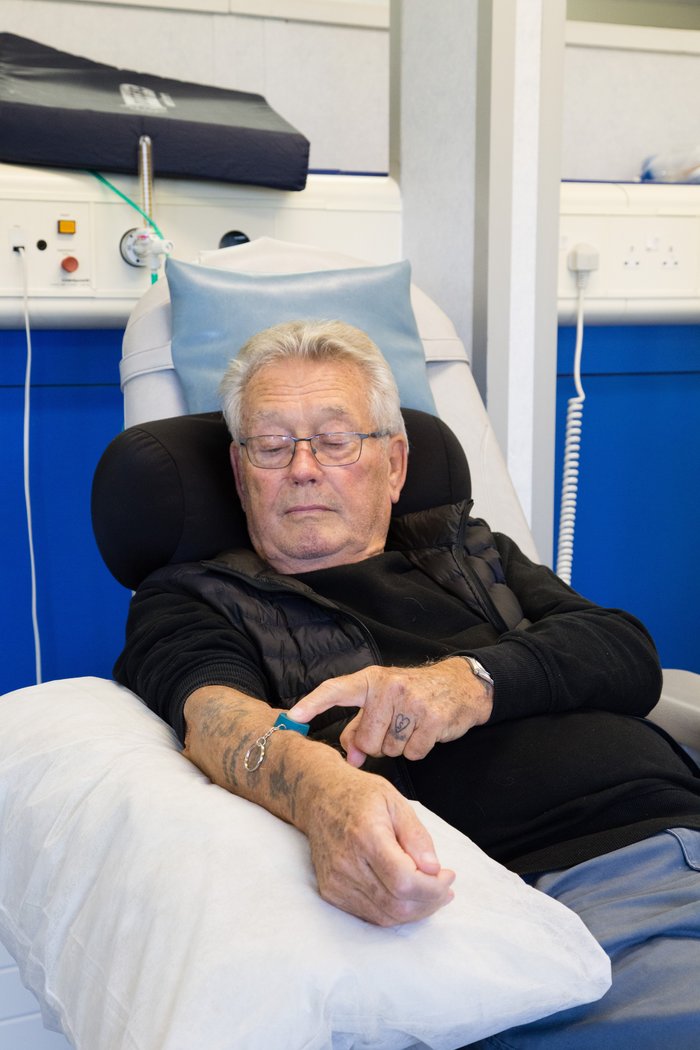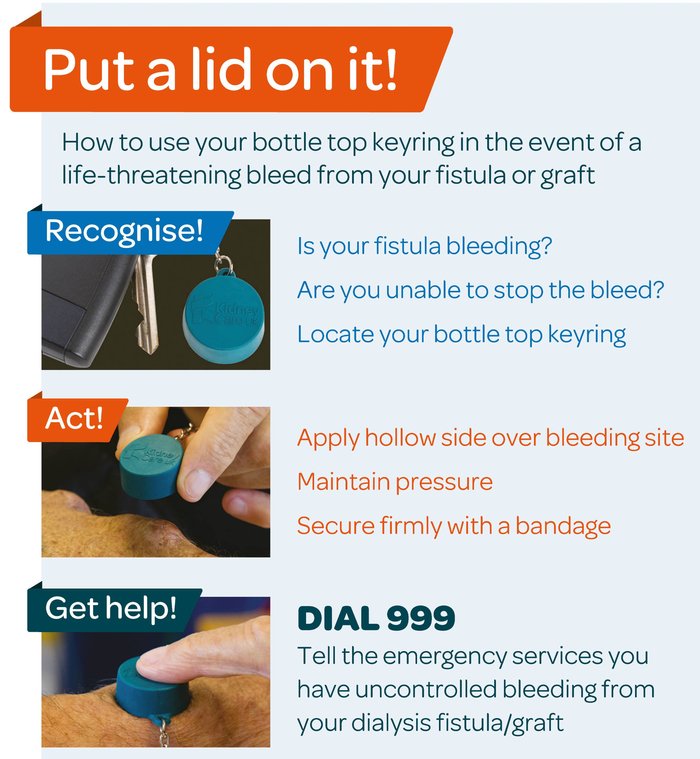Blood loss from a fistula or graft can become life threatening very quickly. Claire Whitehill, Vascular Access Nurse Specialist at the Queen Alexandra Hospital, Portsmouth, explains why it's vital to act fast if you’re bleeding from your fistula or graft and how to use Kidney Care UK's bottle top keyring to help you manage the bleed.
Vascular access is a phrase used to describe the surgical site on the body where blood flows from and returns to the body during haemodialysis (HD).
A vascular access point may be:
- an arteriovenous fistula (artery joined directly to a vein)
- an arteriovenous graft (artery joined to vein using a plastic graft)
- a central venous catheter (a line usually placed into the veins in the neck).
A fistula remains the first choice for HD access due to its longevity and reduced association with death and ill health, but nothing is perfect.

Fistulas and grafts are essential in maintaining a kidney patient’s life. However, it can often be challenging to maintain the function of a fistula or graft, and they frequently require regular intervention and/or surgery to ensure their survival.
People on dialysis often encounter problems such as swelling, redness or discharge over their vascular access. This could indicate an infection, and it can then create a fatal point of weakness in the fistula or graft.
Scabs at needling sites that are raised, enlarging bumps (aneurysms) along the access, shiny skin over the vascular access and/or loss of skin pigment over an aneurysm all require urgent review and, if left untreated, could potentially lead to a life-threatening bleed (LTB).
Managing LTBs (life-threatening bleeds)
Blood loss from a fistula or graft can usually be controlled by applying pressure to the site.
In rare cases the bleeding is not resolved. LTBs from a fistula or graft are significant bleeds that are not stopped by applying the normal amount of pressure used to stop bleeding after dialysis needle removal.
If LTBs occur spontaneously at home between dialysis sessions, away from the clinic and caregiving team, it is vital that patients and carers know what to do. Kidney patients often don’t recognise the signs and symptoms of a potential problem, but time is of the essence and without the correct actions death can unfortunately result within minutes.
Following several reported cases of LTBs, in 2018 the British Renal Society’s (BRS) Vascular Access Special Interest Group and the Vascular Access Society of Britain & Ireland (VASBI) have complied recommendations for the prevention of an LTB from dialysis vascular access and guidance on how to manage LTBs effectively when they do occur.
You should not just rely on your dialysis team to detect a problem with your access. YOU should remain alert and highlight any concerns you may have about your access with your dialysis team.
Your vascular access is your lifeline
Making sure your dialysis access is healthy and functioning properly at all times is essential to your health and wellbeing.
Blood loss from a fistula or graft can usually be controlled by applying pressure to the site. However, sometimes bleeds do not resolve and, due to the rate and volume of blood loss, can become life threatening very quickly.
You should not just rely on your dialysis team to detect a problem with your access. YOU should remain alert and highlight any concerns you may have with your access to your dialysis team.
Managing a bleed from a fistula or graft
The priority with a life-threatening bleed is to get help; do not delay whilst trying to stop the bleed, as loss of consciousness through blood loss can occur quickly.
In this situation, the focus is to stop the bleed and not to preserve the function of your fistula or graft. Alternative access can be created. Remember: there is only one you!
- If a bleed from a fistula or graft cannot be stopped with direct pressure over the affected area, AVOID using large absorbent dressings and/or towels, as this will reduce pressure applied and its effectiveness to control the bleed.
- Locate your bottle top and apply hollow side facing your skin, maintaining pressure. By applying the bottle top to the bleed in this way you have sealed the bleeding area which will encourage the blood to clot more swiftly.
- If no blood is seen coming out from underneath the bottle top, it is safe to assume that the bleeding is controlled.
- If possible, secure the bottle top firmly with a bandage.

How to order a free Kidney Care UK 'Put a lid on it' keyring
Order your free keyring online, or call 01420 541424 (9am-5pm, Mon-Fri) or email your delivery details to [email protected]. We kindly ask that you limit your order to one person so that there is enough for everyone.
We can supply larger quantities of keyrings directly to dialysis units and KPAs, as part of our range of free patient information. Please contact us to check availability if more than 30 keyrings are required.
Please note, there is no charge for keyrings but if you would like to make a donation to support our work with the kidney community you are able to do so by visiting the Kidney Care UK donation page.
The 'Put a lid on it' campaign in Portsmouth
In Portsmouth, a plan to disseminate local guidance that incorporated advice from the BRS and VASBI was developed and implemented in 2019.
"We launched our ’Put a Lid on it!’ campaign with an awareness week," explains Claire Whitehill, Vascular Access Nurse Specialist at the Queen Alexandra Hospital, Portsmouth. "Around 25 members of staff wore brightly coloured campaign logo T-shirts, which encouraged lots of conversations between patients, staff, family members and visitors.
“We also visited or contacted many local organisations that provide NHS care, and where our patients might attend with bleeds from a fistula or graft; this included all A&Es, minor injury units and our local dialysis and satellite units. During the visit, we educated staff on exactly what to do should a patient present with an LTB, provided posters for clinical areas and gave out campaign pens.
"During the week we also spent a lot of time with our patients across the Wessex Kidney Centre area. All patients were given a credit card-sized ‘LTB advice card’ and a bottle top with a demonstration of how to use it in an emergency.
“Patient-focused posters and pop-up banners were also displayed in all patient waiting rooms and lift areas. We also started visiting our patients who are in nursing or care homes to educate the staff there in order to keep our more vulnerable dialysis population safe and well-informed.
"Our clinical lead also collaborated with the South Coast Ambulance Service and, as a result, we have a local policy for telephone advice and direct patient transfer to the regional renal unit for patients with an LTB.
“These recommendations have now been incorporated into the latest national ambulance service trauma guidelines and the NHS 111 and 999 patient assessment algorithms."
NOTE: This article was first published in Issue 7 of our Kidney Matters magazine.
